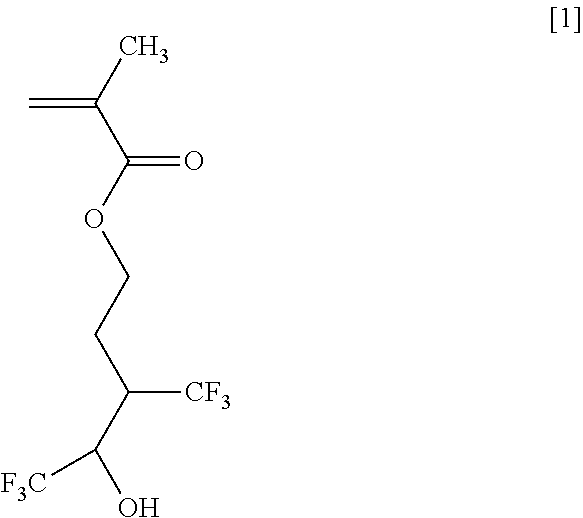Methods for Producing Fluorine-Containing Hydroxyaldehyde, Fluorine-Containing Propanediol, and Fluorine-Containing Alcohol Monomer
- Summary
- Abstract
- Description
- Claims
- Application Information
AI Technical Summary
Benefits of technology
Problems solved by technology
Method used
Image
Examples
example 1
Production of a Fluorine-Containing Hydroxyaldehyde and a Fluorine-Containing Propanediol
[0210]A 1-liter autoclave equipped with a thermometer and a stirring blade was charged with 128.6 g (1.63 mol) of pyridine as an additive, followed by sealing. 177.3 g (1.07 mol) of 1,1,1,3,3,3-hexafluoroacetone was added with stirring at room temperature. Heating was conducted until an inside temperature of 70° C., and a mixed solution of 49.4 g (1.12 mol) of acetaldehyde and 266 g of diisopropyl ether was pressed thereinto by spending 5 hours. After standing still for 15 hours, it was exposed to the atmosphere, thereby obtaining 617 g of a reaction liquid.
[0211]A reaction formula of the above first step is shown as follows.
[0212]Next, the reaction liquid was washed by using 150 ml of 12 N hydrochloric acid aqueous solution. The separated organic layer was washed three times by using 170 ml of water, thereby obtaining 490 g of an organic layer containing a fluorine-containing acetaldehyde. A fl...
example 2
Production of a Fluorine-Containing Hydroxyaldehyde and a Fluorine-Containing Propanediol
[0215]A 300 ml autoclave equipped with a thermometer and a stirring blade was charged with 85.8 g (1.08 mol) of pyridine as an additive and 16.7 g (0.38 mmol) of acetaldehyde, followed by sealing. With stirring, at room temperature, 60.1 g (0.36 mol) of 1,1,1,3,3,3-hexafluoroacetone was added. The autoclave was heated until an inside temperature of 70° C. While maintaining at 70° C., stirring was conducted for 15 hours to conduct the reaction. Then, the autoclave was opened, and 161.4 g of a reaction liquid was obtained.
[0216]To 141 g of this, 75 g of diisopropyl ether was added, followed by washing with 166 ml of a 6 N hydrochloric acid aqueous solution and then washing the organic layer three times using 75 ml of water, thereby obtaining 210 g of the organic layer containing a fluorine-containing acetaldehyde. The above reaction is shown by the reaction formula of the above first step.
[0217]A ...
example 3
Production of a Fluorine-Containing Hydroxyaldehyde
[0218]A 50 ml autoclave having a stirring bar therein was charged with 4.8 g (60.2 mmol) of pyridine as an additive and 1.4 g (31.6 mmol) of acetaldehyde, followed by sealing. Under cooling with dry ice, 5.0 g (30.1 mmol) of 1,1,1,3,3,3-hexafluoroacetone was added. The autoclave was heated to 70° C. While maintaining at 70° C., stirring was conducted for 15 hours, followed by exposure to the atmosphere, thereby obtaining 11.8 g of a reaction liquid. The amount of a fluorine-containing hydroxyaldehyde produced was found to be 4.4 g by an internal standard method using NMR. Yield was 70%.
PUM
| Property | Measurement | Unit |
|---|---|---|
| Acidity | aaaaa | aaaaa |
| Adhesivity | aaaaa | aaaaa |
Abstract
Description
Claims
Application Information
 Login to View More
Login to View More - R&D
- Intellectual Property
- Life Sciences
- Materials
- Tech Scout
- Unparalleled Data Quality
- Higher Quality Content
- 60% Fewer Hallucinations
Browse by: Latest US Patents, China's latest patents, Technical Efficacy Thesaurus, Application Domain, Technology Topic, Popular Technical Reports.
© 2025 PatSnap. All rights reserved.Legal|Privacy policy|Modern Slavery Act Transparency Statement|Sitemap|About US| Contact US: help@patsnap.com



